Plants for Frog Vivariums
Getting Started
 Potting soils listed are types -YOU make sure they are organic, containing NO
added phosphates, plant food or fertilizer! It is suggested that after buying the
plant, you place it in the organic-based soil listed, and grow away from frog
for 6 to 8 weeks before adding to the Vivarium.
Potting soils listed are types -YOU make sure they are organic, containing NO
added phosphates, plant food or fertilizer! It is suggested that after buying the
plant, you place it in the organic-based soil listed, and grow away from frog
for 6 to 8 weeks before adding to the Vivarium.
What this will do is allow any chemicals and fertilizers that were added to the soil mixture the nursery used to originally grow the plant, will grow out and not contaminate your pets.
Bamboo
 Bamboo is a great vivarium plant for many types of frog vivariums. It will need good lighting, and can be grown in either the vivarium soil or water. They grow quickly, and can be cultivated into even more stalks simply but cutting above one of the nodules and re-planting the unrooted top into a cup of water for a month or so.
Bamboo is a great vivarium plant for many types of frog vivariums. It will need good lighting, and can be grown in either the vivarium soil or water. They grow quickly, and can be cultivated into even more stalks simply but cutting above one of the nodules and re-planting the unrooted top into a cup of water for a month or so.
Bamboo can be readily purchased from Home Depot or Lowes. Look for the bamboo they carry that is loosely grown in water pails. I paid $10.00 for a stalk that was apporximately 18" tall. I took it home, divided it as I mentioned above, and let grow in treated froggy style water for about 6 weeks. I then placed it in my Litorias' vivarium. Within a month, it is ready to top and I'll be able to grow still another stalk and place in another vivarium!
Should your lighting source not be strong enough, it will begin to grow quite leggy, so up the lighting source in that case, being sure to protect the frogs from any direct sunlight or overheating. Keep the roots moist. I do directly plant mine in Scotts brand peatmoss with a sphagnum moss bottom base, which is directly over a false bottom.
This plant seems to do well in warm as well as cool tanks, but good humidity is vital to keep it thriving.
Cynoches
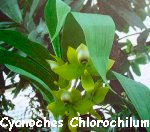 Cynoches is in the Orchid family, and grows sturdy and strong. It
requires much light, but no direct sun, so is excellent for larger
Vivarium. This Orchid is also easy to care for, good for
Beginners. It is usually found in the fall in many of the larger
Nurseries and Garden Centers like Home Depot, WalMart and Lowes.
Cynoches is in the Orchid family, and grows sturdy and strong. It
requires much light, but no direct sun, so is excellent for larger
Vivarium. This Orchid is also easy to care for, good for
Beginners. It is usually found in the fall in many of the larger
Nurseries and Garden Centers like Home Depot, WalMart and Lowes.
Keep it moderately moist during its growing season, and cut down on water intake in the winter. Give it an orchid mix soil in a lattice basket you have attached to the cork sheet back of your vivarium. Make sure the Vivarium is properly ventilated.
Dendrobium
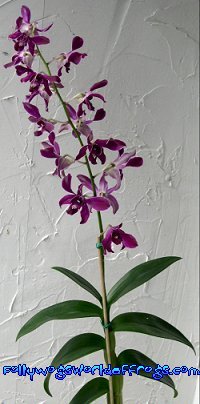 Dendrobium
is an excellent choice of orchid for a tropical, subtropical, or even cloudforest style vivarium. Since this orchid does well indoors with just minimum care, if you can provide their few requirements you can have a vivaqrium that sports beautiful flowers once yearly, and consists of strong, sturdy thick green foilage year round.
Dendrobium
is an excellent choice of orchid for a tropical, subtropical, or even cloudforest style vivarium. Since this orchid does well indoors with just minimum care, if you can provide their few requirements you can have a vivaqrium that sports beautiful flowers once yearly, and consists of strong, sturdy thick green foilage year round.
The roots on this type of orchid are built more for arial life, so they are naturally brown and strong, like thick twine. After allowing the strong fertilizers that have come with your flowering orchid to be used up by the plant (usually 6 to 8 weeks of no fertilizing and no frog tank planting!) you can then gingerly remove it from the pot it came in, being careful not to break the anchoring roots, which sometimes have grown right onto the sides of the clay pot; and begin the process of placing in your frogs' home.
If you're going to place it on the cork backing, the frogs will have to all be removed for now. Time this type of planting with your normal cleaning schedule, and have the tank ready in advance. When plant is loose, hold it up against the walls to figure out where it looks best for you and the frogs. Using silicone glue, attach a few of the sturdier roots onto the wall, being sure not to coat the entire root, just allow it support. Use either garbage bag ties that anchor into a nearby limb or duck tape to hold the plant in place until the glue dries overnight.
Another method of planting is much simpler. Just simply place the entire plant, clay pot and all, into the vivarium. Or maybe you want to sink it into the soil so that the pot is unseen. The choice is yours. Just remember, this plant does'nt like as much direct watering as most people think...so if sinking it into the soil, make sure not to water that area too much.
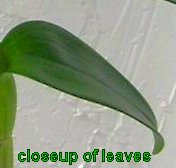 Give the plant bright indirect sun-lighting, or direct lighting with a plant light or two strong fluorescents. It enjoys regular tropical treefrog temperature ranges, with your regular evening temp drop-off. Only water the plant when the soil or orchid medium surrounding it is completely dry. To fertilize (and cause it to rebloom) place your froggie's dried poops under the plant's medium and near roots. When the plant is not blooming, try buying a silk orchid bloom and tucking it into a position that makes it look as though it is still blooming.
Give the plant bright indirect sun-lighting, or direct lighting with a plant light or two strong fluorescents. It enjoys regular tropical treefrog temperature ranges, with your regular evening temp drop-off. Only water the plant when the soil or orchid medium surrounding it is completely dry. To fertilize (and cause it to rebloom) place your froggie's dried poops under the plant's medium and near roots. When the plant is not blooming, try buying a silk orchid bloom and tucking it into a position that makes it look as though it is still blooming.
If the plant becomes leggy, you need to give it more lighting. If it begins to yellow, you're either overwatering or underwatering. Overwatering and leaf is bloated; under and its dry and tip may look rusted. Don't remove dried or dead leaves, the plant reuses the nutrients contained within them to help feed itself. If you're doing everything right, it will grow a pair of new leaves every year.
Gasteria
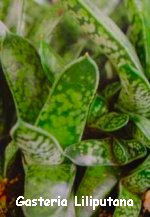 Gasteria are succulent plants with very short trunks and often leaves
in double rows. Give this Savannah-Vivarium plant sparse water and much
overhead light with no obstruction to light. In Winter, water only
enough to keep the leaves from drying out. A sturdy plant that will
grow tall. Place in mid to back of the Vivarium. Great plant for
larger Monkey frogs to climb upon, as it will support their weight
without breaking. Give it a cactus type soil.
Gasteria are succulent plants with very short trunks and often leaves
in double rows. Give this Savannah-Vivarium plant sparse water and much
overhead light with no obstruction to light. In Winter, water only
enough to keep the leaves from drying out. A sturdy plant that will
grow tall. Place in mid to back of the Vivarium. Great plant for
larger Monkey frogs to climb upon, as it will support their weight
without breaking. Give it a cactus type soil.
The verrucosa, shown underneath the lilliputna, is less sturdy but also useful. Use in Vivariums with younger Waxys or the striped leg Monkey frogs.
Heliconia
![]()
 Heliconia
are actually related to Banana plants. They need a large
Sub-tropical to Tropical Vivarium with a deep soil-base that provides
good drainage. They will thrive with full exposure to your
over-head UV-B lighting. In winter allow the plant soil to only
slightly dry, and the rest of the year keep the plants' roots
just slightly moist. It likes humidity too. If your Vivarium
is large enough, this is a great plant for larger tropical
treefrogs, as the leaves are sturdy. Can grow to over 3' tall
with optimum conditions.
Heliconia
are actually related to Banana plants. They need a large
Sub-tropical to Tropical Vivarium with a deep soil-base that provides
good drainage. They will thrive with full exposure to your
over-head UV-B lighting. In winter allow the plant soil to only
slightly dry, and the rest of the year keep the plants' roots
just slightly moist. It likes humidity too. If your Vivarium
is large enough, this is a great plant for larger tropical
treefrogs, as the leaves are sturdy. Can grow to over 3' tall
with optimum conditions.
Water Hyacinth
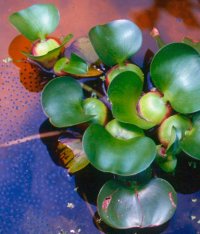 Water hyacinth
is actually known more as a nuisance here in Southern Florida, where
it clogs our canals and many parts of 'the sea of grass', better known
as the everglades.
Water hyacinth
is actually known more as a nuisance here in Southern Florida, where
it clogs our canals and many parts of 'the sea of grass', better known
as the everglades.
However, it makes a great plant for boggy or aquatic vivariums. The long, white hairy roots that hang down from the plant actually help to pull noxious nasties from the water, such as phosphorous, ammonia, nitrates and nitrites. In spring and summer, they send up a stalk from near center of the plant that will hold a bunch of lavender flowers resembling the famous hyacinth of spring, hence the name.
They will need bright light and good air circulation to survive, plus headroom if in an aquatic setup. You can sometimes find them in the northern parts of the U.S. in Garden shops or Pond Supply outlets.
Lithops
 Fenestaria aurantica
is a great ground cover plant for Savannah
Vivariums or outdoor enclosures that receive much light. They require
cactus type soil. After the miniature flowers appear, keep the plant cooler
or it will die back. This plant is easy to grow from seed, and may be a
benefit for you to do so, as plants grown from seed usually tolerate
the environment you have them in much better than those transplanted.
Likes bright light, so keep it open to your overhead lighting. Do not
add any extra water to it after it flowers, wait until spring to begin
adding water directly to the plant again.
Fenestaria aurantica
is a great ground cover plant for Savannah
Vivariums or outdoor enclosures that receive much light. They require
cactus type soil. After the miniature flowers appear, keep the plant cooler
or it will die back. This plant is easy to grow from seed, and may be a
benefit for you to do so, as plants grown from seed usually tolerate
the environment you have them in much better than those transplanted.
Likes bright light, so keep it open to your overhead lighting. Do not
add any extra water to it after it flowers, wait until spring to begin
adding water directly to the plant again.
Monstera
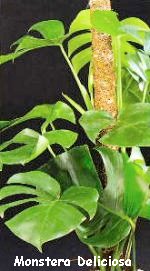 Monstera
is also called the 'Swiss cheese plant'. A popular and quite
strong plant, Monstera sends out many aerial root-shoots that will attach themselves
to a coconut fiber or cork backed Vivarium. Plant likes moisture, so use in
Tropical to Sub-Tropical Vivariums. Keep it warm and well-lit so it won't get
leggy. No direct sun should ever hit its foliage. Place in standard potting soil mix,
and wipe leaves clean with distilled water once every month or so. Red-Eyed
treefrogs love this plant, as do dendrobates and Mantellas.
Monstera
is also called the 'Swiss cheese plant'. A popular and quite
strong plant, Monstera sends out many aerial root-shoots that will attach themselves
to a coconut fiber or cork backed Vivarium. Plant likes moisture, so use in
Tropical to Sub-Tropical Vivariums. Keep it warm and well-lit so it won't get
leggy. No direct sun should ever hit its foliage. Place in standard potting soil mix,
and wipe leaves clean with distilled water once every month or so. Red-Eyed
treefrogs love this plant, as do dendrobates and Mantellas.
Peperomia
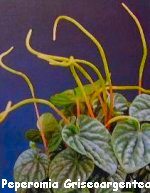 Peperomia have strongly ribbed leaves of a metallic green-gray.
When it flowers, these appear on the ends of long, narrow spikes.
The lighter the foliage, the more light you will want to give the
plant. It does well in Vivariums that are moderately humid. Sub-Tropical
to Cloud Forest Vivariums are the best for Peperomia. Never over-water, and always
use warmed rain or distilled water.
Peperomia have strongly ribbed leaves of a metallic green-gray.
When it flowers, these appear on the ends of long, narrow spikes.
The lighter the foliage, the more light you will want to give the
plant. It does well in Vivariums that are moderately humid. Sub-Tropical
to Cloud Forest Vivariums are the best for Peperomia. Never over-water, and always
use warmed rain or distilled water.
Bromeliad or Orchid soil is good to use. It is a low-growing plant that should be planted mid to back of the Vivarium. In the winter months cut watering in half and return to regular watering again in Spring.
Philodendron
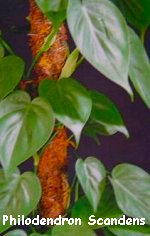 Philodendrons are easy to care for and quite prolific. A great
climber. Attach it to your cork-backed Vivarium wall and watch it
shoot up. Anchor it either in a coconut-fiber basket you have cut in
half and stuffed with orchid mix, or wrap the root ball with sphagnum
and orchid bark and tie off with non-toxic plastic covered wire. Use
more wire to attach to the Vivarium wall.
Philodendrons are easy to care for and quite prolific. A great
climber. Attach it to your cork-backed Vivarium wall and watch it
shoot up. Anchor it either in a coconut-fiber basket you have cut in
half and stuffed with orchid mix, or wrap the root ball with sphagnum
and orchid bark and tie off with non-toxic plastic covered wire. Use
more wire to attach to the Vivarium wall.
It likes bright light and keep it moist for best growth. You will most likely have to pinch off the top now and again, as it grows quickly. You can use it in a Tropical to Sub-Tropical setup. Pinch off any leaves that are turning yellow, being careful no frogs are underneath the leaves before disposing of.
Pistia
 Pistia is also called 'Water lettuce' or 'Nile lettuce'.
It floats & proliferates in the tropics
and sub-tropics, often clogging canals and other waterways. It
will grow in your Vivarium with proper care.
Pistia is also called 'Water lettuce' or 'Nile lettuce'.
It floats & proliferates in the tropics
and sub-tropics, often clogging canals and other waterways. It
will grow in your Vivarium with proper care.
The pool of water in your Vivarium will need to stay a constant temperature and be of gentle movement. It will also need direct lighting from your UV-B lights. If the plants' leaves become lanky, you have not met its lighting requirements and it will eventually die without stronger lighting. It's roots will eventually drag the pools' bottom, and this is good. Pistia will derive any nutrients it needs from the water, and mine actually seem to help keep the water clarified. Of course, Sub-Tropical to Tropical temperatures are best for it.
If the plants' roots develop algae, you will need to pinch those roots off, as they strangle the plant. Fire-bellied toads will perch in them. They are one of the only plants you can actually keep with the Xenopus frogs. They will occasionally get some roots, but ultimately this tough plant will be able to live through their abuse if the tank is large enough.
Papyrus
 Papyrus is another plant that loves water. Unlike Pistia, it does
not normally sit in the water, but can easily withstand flooded
roots. Place it at the pools' edge, and keep very very moist.
Papyrus is another plant that loves water. Unlike Pistia, it does
not normally sit in the water, but can easily withstand flooded
roots. Place it at the pools' edge, and keep very very moist.
Give it high light. Great for Sub-Tropical and Tropical Vivariums. Also great for pipid tanks. Use potting soil with some sand added for good drainage.
For use with pipids, take a finely meshed netting bag from a bag of onions. carefully cut the top, making a very small hole. Place a heavy stone in bottom. Stuff with unground sphagnum moss on outside, add soil to center. make a hole in center with your finger, add papyrus roots. Place a loose-fitting rubber band around the top of mesh bag to enclose plant within bag, and now sink to shallow area of pipid tank you want. About 2" to 3" of the plant can thrive underwater with no distress.
Sanservia
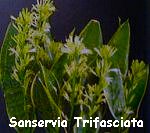 Sanservia
is one of the toughest plants ever. It can take on a wide
range of environments, including Sub-Tropical to Savannah. Low light to
high light, and the same with watering. A sturdy and upright plant,
use it in either of the above Vivariums, and water according to which setup
it is in. It grows in standard potting soil and will easily support
the weight of even the largest treefrogs. Also good to place with
Temperate Vivariums. Rana species will enjoy resting in front of them.
Sanservia
is one of the toughest plants ever. It can take on a wide
range of environments, including Sub-Tropical to Savannah. Low light to
high light, and the same with watering. A sturdy and upright plant,
use it in either of the above Vivariums, and water according to which setup
it is in. It grows in standard potting soil and will easily support
the weight of even the largest treefrogs. Also good to place with
Temperate Vivariums. Rana species will enjoy resting in front of them.
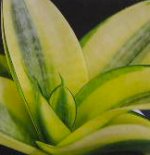 Both varieties pictured do very well in Vivariums. You may wish to plant
the trifasciata species in a taller tank, as it grows up to 2 feet tall.
The bottom variety shown is good for Vivariums that are longer than they are
tall. Look great grown in groupings.
Both varieties pictured do very well in Vivariums. You may wish to plant
the trifasciata species in a taller tank, as it grows up to 2 feet tall.
The bottom variety shown is good for Vivariums that are longer than they are
tall. Look great grown in groupings.
Euphorbia
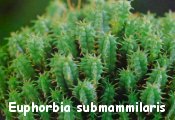 Euphorbia family contains some strange but beautiful
examples of plants. The one pictured is originally from South Africa.
Although it looks like a cactus, it is a succulent and the spines
are quite soft, unable to hurt your frogs.
Euphorbia family contains some strange but beautiful
examples of plants. The one pictured is originally from South Africa.
Although it looks like a cactus, it is a succulent and the spines
are quite soft, unable to hurt your frogs.
The plant grows low and spreads horizontally, so is better planted near the front or mid-front of your Savannah-style Vivarium. Make sure it is receiving direct overhead lighting with no obstruction. It does quite well in outdoor screened enclosures that receive some direct sun. Keep it warm and water sparsely, drier in the winter months. It likes a cactus type soil. My waxy Monkey treefrogs love climbing among this plant.
Selaginella
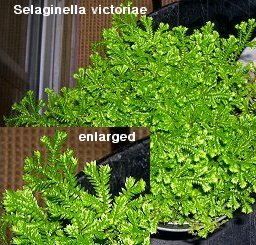 Selaginella victoriae is a mosslike plant that has yellowish tips on the ends of its fronds. Grows to approximately
6" in height, although probably not this tall in a Vivarium. Spreads through tiny
roots on the fronds, makes a good ground cover in a 55 gallon and up.
Selaginella victoriae is a mosslike plant that has yellowish tips on the ends of its fronds. Grows to approximately
6" in height, although probably not this tall in a Vivarium. Spreads through tiny
roots on the fronds, makes a good ground cover in a 55 gallon and up.
It enjoys low light with moderately moist soil, so is perfect for Vivarium use. It enjoys the average temperatures present in ones' home as well. 55 ° to 70 °. Do not allow the soil to become boggish where it lives, as this will cause root rot and the plant will die. Placing next to a 'waterfall' in the Vivarium is a good place if you want to allow the plant to reach its full height.
Myrmecodia
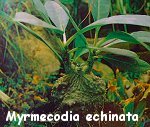 Myrmecodia echinata
is an epiphytic
plant from Southeast Asia. It grows well in
Sub-Tropical and Tropical Vivariums. In Nature, the tubers in its'
base are inhabited by ants. The plant naturally provides 'corridors'
for this to happen. So you may be able to get double-use out of the plant
as an ant-farm too, supplying your frogs with a constant source of
black ants.
Myrmecodia echinata
is an epiphytic
plant from Southeast Asia. It grows well in
Sub-Tropical and Tropical Vivariums. In Nature, the tubers in its'
base are inhabited by ants. The plant naturally provides 'corridors'
for this to happen. So you may be able to get double-use out of the plant
as an ant-farm too, supplying your frogs with a constant source of
black ants.
It enjoys a warm spot in the Vivarium with only the lighting your Set-up provides, no external light source is needed. It enjoys high humidity and soft to distilled water on its roots. Plant it in sphagnum moss and the addition of rock wool flakes helps to feed it. You can allow it to grow on the floor of the Vivarium or attach it with non-toxic plastic covered wire to the back-wall of the Vivarium. Stuff the sphagnum and wool flakes under the root-ball before attachment. Keep moist except in winter, when you can allow it to dry ever so slightly. The leaves may fall off, a sign of over-watering and/or not enough light. Remedy these situation(s) and they will grow back.
Dichondra
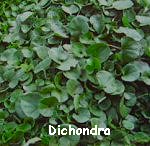 Dichondra is a lovely lily-pad shaped leaf ground cover that you can
use as a substitute for moss in Indoor kept Temperate and Sub-Tropical to Tropical Vivariums.
Ususally growing no taller than an inch, in Florida it naturally grows
in the shadier spots underneath large
tree canopies. I have seen it in full sun, but it only does well
in this spot when it becomes shaded within a few hours by a building
or tree.
Dichondra is a lovely lily-pad shaped leaf ground cover that you can
use as a substitute for moss in Indoor kept Temperate and Sub-Tropical to Tropical Vivariums.
Ususally growing no taller than an inch, in Florida it naturally grows
in the shadier spots underneath large
tree canopies. I have seen it in full sun, but it only does well
in this spot when it becomes shaded within a few hours by a building
or tree.
Dichondra enjoys a bright tank when grown indoors, and moist standard potting mix soil with a bit of sand added. You can grow it from seed or started plants. It is easier to care for than live moss, and when treated properly will spread out across your entire Vivarium. Lessen watering in the winter months.
Here is a great source for the seed, it's very easy to get started: Ground cover Dichondra at Park Seed. Try this variety for hanging basket style: Park Seed, Hanging Basket Dichondra.
Syngonium
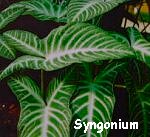 Synognium is a member of the Philodendron family,
and is a vigorous
climber with thin leaves. A good Tropical to Sub-tropical Vivarium
plant for smaller frogs, Syngonium likes warmth and high light.
It will attach itself to the cork sheeting on the Vivarium back if
you plant it in the soil near it. Keep the soil lightly moist.
Reduce watering in winter. It likes a standard potting mix with
some sand added for good drainage. It is also easy to propagate
from leaf cuttings.
Synognium is a member of the Philodendron family,
and is a vigorous
climber with thin leaves. A good Tropical to Sub-tropical Vivarium
plant for smaller frogs, Syngonium likes warmth and high light.
It will attach itself to the cork sheeting on the Vivarium back if
you plant it in the soil near it. Keep the soil lightly moist.
Reduce watering in winter. It likes a standard potting mix with
some sand added for good drainage. It is also easy to propagate
from leaf cuttings.
Ferns
 Adiantum species
shown is capillisveneris.
These ferns are delicate to look at, but sturdy in the Temperate
and Cloud Forest style Vivariums. Great for Rana frogs that naturally
live in northern
climates. It prefers a loamy soil with sand mixed in. In a
Vivarium environment, you can give it bright light. Keep the soil
slightly moist.
Adiantum species
shown is capillisveneris.
These ferns are delicate to look at, but sturdy in the Temperate
and Cloud Forest style Vivariums. Great for Rana frogs that naturally
live in northern
climates. It prefers a loamy soil with sand mixed in. In a
Vivarium environment, you can give it bright light. Keep the soil
slightly moist.
Temperatures between 75 ° and 50 ° will keep this fern thriving.
Chlorophytum
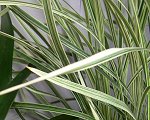 Chlorophytum
has species in the genera that include the well-known 'Spiderplant.'
The main plant
sends out many spidery 'arms' with tiny plants attached to the
ends. The one pictured to your left is a grass-like species that is also
good for planting in your substrate. The spider is great for a hanging basket in the Sub-Tropical to Temperate
Vivarium, or you can attach it directly onto the cork sheet inside
a halved coconut husked basket.
Chlorophytum
has species in the genera that include the well-known 'Spiderplant.'
The main plant
sends out many spidery 'arms' with tiny plants attached to the
ends. The one pictured to your left is a grass-like species that is also
good for planting in your substrate. The spider is great for a hanging basket in the Sub-Tropical to Temperate
Vivarium, or you can attach it directly onto the cork sheet inside
a halved coconut husked basket.
Give it standard potting soil with some sphagnum moss mixed in. Keep it slightly moist at all times. Bright light from your UV-B works well for this plant. Lessen water in winter time. You can pinch off any dead leaves. If its a spiderplant, pinch off the baby plants and re-plant them.
Guzmania and Bromeliads
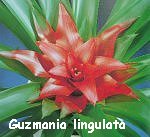 Guzmania lingulata Guzmanina is an excellent choice in bromeliads for use in tropical and
cloudforest setups. Spineless and sturdy, for those of you trying to breed
frogs that need a bromeliad cup to lay their eggs, guzmania is perfect.
Attach to the cork backing of your vivarium, or place wire around its base and attach
to logs.
Guzmania lingulata Guzmanina is an excellent choice in bromeliads for use in tropical and
cloudforest setups. Spineless and sturdy, for those of you trying to breed
frogs that need a bromeliad cup to lay their eggs, guzmania is perfect.
Attach to the cork backing of your vivarium, or place wire around its base and attach
to logs.
Water it in the center-cup, using only treated and/or distilled water. Fertilize once monthly using poop from the frogs, as this will not kill the frogs as it would using traditional human-made fertilizers. Place this at its' base and in the water-cup. Use strong lighting, using a plant-gro bulb directly over it (can double as basking lamp). Additional lighting can include two strip fluorescents that are of daylight quality.
Eventually the "mother plant" will die, but leave at her feet, young bromeliads, called "pups". These will live off the mother plant and eventually replace her.
Live Moss
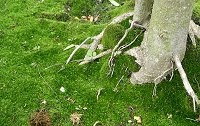 Live moss is an excellent floor covering for a well-maintained vivarium.
It does require some special care. UVB lighting for two hours daily
in a heavily planted vivarium, along with a moist environment
are at a premium to keep it healthy and from breaking apart.
Live moss is an excellent floor covering for a well-maintained vivarium.
It does require some special care. UVB lighting for two hours daily
in a heavily planted vivarium, along with a moist environment
are at a premium to keep it healthy and from breaking apart.
Moss naturally lives on every continent on planet Earth except Anartica. There are several thousand different species. One thing they all have in common: Good air quality is a sign of their remaining healthy. Pollution affects moss dramatically. If yours begins to turn brown and die, then either of the three things mentioned could be the problem.
Many froggers opt not to use moss as a floor cover because it is harder to keep alive than dichondra. Others go with "Bed-a-Beast". The reasons for this is simple. The lodging of foreign material like moss in your frogs throat or stomach can cause impaction ,which is deadly.
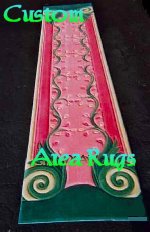 I personally don't care for the "Bed-a-Beast" because of the
appearance of the vivarium. It also ends up all over the frog, which
must be annoying. (Watch them constantly using their back legs to
try and rub themselves free of it). If you feel you don't have
a green thumb and can't maintain living moss, try for organic foam with a sprinkling of river stones, Scotts peat moss
or dichondra as a floor cover instead.
I personally don't care for the "Bed-a-Beast" because of the
appearance of the vivarium. It also ends up all over the frog, which
must be annoying. (Watch them constantly using their back legs to
try and rub themselves free of it). If you feel you don't have
a green thumb and can't maintain living moss, try for organic foam with a sprinkling of river stones, Scotts peat moss
or dichondra as a floor cover instead.
Cricket Bites & Live Plants
I have found a couple of other reasons to use live moss as well. When
feeding crickets to your pets, any escapees will hide and breed
in the damp moss. Within a few weeks, you'll have any number of tiny pinhead
crickets that have been born out of the moss, a ready feeding supply to your frogs!
Another great thing is that the crickets will munch on the moss, instead of
your frogs' skin. Crickets do bite/eat your frogs' skin if they escape
from being eaten and have no other live plant food in the tank... just about any living plant can help keep the crickets from biting the frogs!
Bottom line, Live Moss does look lovely and is more natural. Green-thumbers, go for it!

